A Web-Based Application to Monitor and Inform about the COVID-19 Outbreak in Italy: The {COVID-19ita} Initiative
Abstract
:1. Introduction
2. Materials and Methods
2.1. WEB App Structure
- (1)
- Upload any changes that have been saved to the UBEP’s Github repository
- (2)
- Pull the daily Updates concerning the COVID-19 data
- (3)
- Save the log of the operations performed on the web app code and system on my SQL database.
2.2. Data
- The Italian regions compile the data by 16:30 on a web application provided by the National Health Institute (Istituto Superiore di Sanità).
- The Ministry of Health receives the data, performs a data quality control procedure, and then sends back the records to the Department of Civil Protection by 17:00.
- The Department of Civil Protection performs another data quality control procedure by 18:00, processes the data, and eventually publishes the database on GitHub.
- The official data web portal also provides ex-post control through a specific GitHub issue module that can be opened by the community. As a consequence of this review process, the official data on epidemic trends in Italy can be subject to retrospective reviews and updates.
2.3. Indicators
2.4. R-Package
3. Results
3.1. Web Application
- (1)
- Analysis of mortality in Veneto. The excess mortality estimation was performed on the Veneto region during the early phase of the pandemic by comparing the mortality by territorial levels (provinces) in March 2020 with the same time frame of the same years (Figure 1). The analysis of COVID-19 mortality in Veneto has also been published elsewhere [16].
- (2)
- Effect of swab policy. To assess the potential impact of the swab policy, the web tool compares the Veneto and Piedmont regions, which followed different policies. In Italy, during the early stages of the pandemic, Veneto adopted a more broad-based testing policy than Piedmont. The Veneto swab model has been applied to Piedmont to predict hospitalizations. In particular, Figure 2 shows that based on the total number of cases, Piedmont and Veneto should have approximately the same number of hospitalizations: on the top side of the figure, this is represented by the two red and green curves, which are almost superimposed. However, if we also visualize the real data of the hospitalizations (red circles) on the graph, we observe that in Piedmont, the hospitalizations are higher than those in Veneto. The plot reported on the bottom side of the web page demonstrates that, including as a covariate in the model the number of swabs performed over time, it is possible to observe that the Veneto model predicts with a good approximation the hospitalizations in Piedmont, thus explaining the observed difference among regions (Figure 2). A comparative analysis between the Veneto and Piedmont regions has also been reported in the literature [17].
- (3)
- Preliminary impact of the containment policy in Veneto. The web app reports a first-look impression of the possible effect of the health policies implemented in Veneto to contain the spread of COVID-19 during the early phases of the pandemic. The plot reported in Figure 3 compared the predictable trend based on data as of March 3 with the trend observed in the Veneto region to understand whether some or all of the actions implemented had a plausible effect of slowing down the evolution of the epidemic. The figure shows a slowdown after 2 March, the day on which a changepoint in the epidemic trend was observed. Based on this comparison (estimated curve on 2 March and data observed in the following days), it was possible to estimate some indicators, for example:
- The number of positive cases avoided as of 12 March in Veneto is 348 (95% CI = 322–373);
- A slowdown of the epidemic to 12 March is equal to 15.91 cases/day (95% CI = 11.99–19.82), with a peak on 6 March of 40 cases/day fewer than expected. The same analysis was performed on the Veneto hospitalization data as reported elsewhere [18].
- Total COVID-19 cases in absolute value and over a population of 10,000 residents;
- Daily cases in absolute value, over a population of 10,000 residents, and on a standardized scale; and
- The average number of cases over a seven-day window on absolute and standardized scales.
3.2. Web Application Number of Connections
4. Discussion
4.1. Limitations
4.2. Future Research Developments
5. Conclusions
Supplementary Materials
Author Contributions
Funding
Institutional Review Board Statement
Informed Consent Statement
Data Availability Statement
Conflicts of Interest
References
- Organisation for Economic Co-operation and Development. Transparency, Communication and Trust: The Role of Public Communication in Responding to the Wave of Disinformation about the New Coronavirus; OECD: Paris, France, 2020. [Google Scholar] [CrossRef]
- Budd, J.; Miller, B.S.; Manning, E.M.; Lampos, V.; Zhuang, M.; Edelstein, M.; Rees, G.; Emery, V.C.; Stevens, M.M.; Keegan, N.; et al. Digital Technologies in the Public-Health Response to COVID-19. Nat. Med. 2020, 26, 1183–1192. [Google Scholar] [CrossRef] [PubMed]
- Communicating During an Outbreak or Public Health Investigation | Epidemic Intelligence Service | CDC. Available online: https://www.cdc.gov/eis/field-epi-manual/chapters/Communicating-Investigation.html (accessed on 20 March 2020).
- Fang, Y.; Nie, Y.; Penny, M. Transmission Dynamics of the COVID-19 Outbreak and Effectiveness of Government Interventions: A Data-driven Analysis. J. Med. Virol. 2020, 92, 645–659. [Google Scholar] [CrossRef] [PubMed] [Green Version]
- O’Malley, P.; Rainford, J.; Thompson, A. Transparency during Public Health Emergencies: From Rhetoric to Reality. Bull. World Health Organ. 2009, 87, 614–618. [Google Scholar] [CrossRef]
- Dong, E.; Du, H.; Gardner, L. An Interactive Web-Based Dashboard to Track COVID-19 in Real Time. Lancet Infect. Dis. 2020, 20, 533–534. [Google Scholar] [CrossRef]
- Valls, J.; Tobías, A.; Satorra, P.; Tebé, C. COVID19-Tracker: A shiny app to nalise data on SARS-CoV-2 epidemic in Spain. Gac. Sanit. 2021, 35, 99–101. [Google Scholar] [CrossRef] [PubMed]
- Wissel, B.D.; Van Camp, P.J.; Kouril, M.; Weis, C.; Glauser, T.A.; White, P.S.; Kohane, I.S.; Dexheimer, J.W. An Interactive Online Dashboard for Tracking COVID-19 in U.S. Counties, Cities, and States in Real Time. J. Am. Med. Inform. Assoc. 2020, 27, 1121–1125. [Google Scholar] [CrossRef] [PubMed]
- Berry, I.; Soucy, J.-P.R.; Tuite, A.; Fisman, D.; COVID-19 Canada Open Data Working Group. Open Access Epidemiologic Data and an Interactive Dashboard to Monitor the COVID-19 Outbreak in Canada. Can. Med. Assoc. J. 2020, 192, E420. [Google Scholar] [CrossRef] [PubMed] [Green Version]
- Komenda, M.; Bulhart, V.; Karolyi, M.; Jarkovský, J.; Mužík, J.; Májek, O.; Šnajdrová, L.; Růžičková, P.; Rážová, J.; Prymula, R.; et al. Complex Reporting of the COVID-19 Epidemic in the Czech Republic: Use of an Interactive Web-Based App in Practice. J. Med. Internet Res. 2020, 22, e19367. [Google Scholar] [CrossRef]
- Organisation for Economic Co-operation and Development. Enhancing Access to and Sharing of Data; OECD: Paris, France, 2019. [Google Scholar]
- Italian Civil Protection. 2020. Available online: http://www.protezionecivile.it/web/guest/homepro (accessed on 20 February 2022).
- Perez-Riverol, Y.; Gatto, L.; Wang, R.; Sachsenberg, T.; Uszkoreit, J.; Leprevost, F.d.V.; Fufezan, C.; Ternent, T.; Eglen, S.J.; Katz, D.S.; et al. Ten Simple Rules for Taking Advantage of Git and GitHub. PLOS Comput. Biol. 2016, 12, e1004947. [Google Scholar] [CrossRef] [Green Version]
- Trauer, J.M.; Ragonnet, R.; Doan, T.N.; McBryde, E.S. Modular Programming for Tuberculosis Control, the “AuTuMN” Platform. BMC Infect. Dis. 2017, 17, 546. [Google Scholar] [CrossRef]
- McCurdie, T.; Taneva, S.; Casselman, M.; Yeung, M.; McDaniel, C.; Ho, W.; Cafazzo, J. MHealth Consumer Apps: The Case for User-Centered Design. Biomed. Instrum. Technol. 2012, 46, 49–56. [Google Scholar] [CrossRef] [Green Version]
- Gallo, E.; Prosepe, I.; Lorenzoni, G.; Acar, A.Ş.; Lanera, C.; Berchialla, P.; Azzolina, D.; Gregori, D. Excess of All-Cause Mortality Is Only Partially Explained by COVID-19 in Veneto (Italy) during Spring Outbreak. BMC Public Health 2021, 21, 797. [Google Scholar] [CrossRef]
- Berchialla, P.; Giraudo, M.T.; Fava, C.; Ricotti, A.; Saglio, G.; Lorenzoni, G.; Sciannameo, V.; Urru, S.; Prosepe, I.; Lanera, C.; et al. To Swab or Not to Swab? The Lesson Learned in Italy in the Early Stage of the COVID-19 Pandemic. Appl. Sci. 2021, 11, 4042. [Google Scholar]
- Gregori, D.; Azzolina, D.; Lanera, C.; Prosepe, I.; Destro, N.; Lorenzoni, G.; Berchialla, P. A First Estimation of the Impact of Public Health Actions against COVID-19 in Veneto (Italy). J. Epidemiol. Community Health 2020, 74, 858–860. [Google Scholar] [CrossRef]
- Lorenzoni, G.; Lanera, C.; Azzolina, D.; Berchialla, P.; Gregori, D.; COVID19ita Working Group. Is a More Aggressive COVID-19 Case Detection Approach Mitigating the Burden on ICUs? Some Reflections from Italy. Crit. Care 2020, 24, 175. [Google Scholar] [CrossRef]
- Hyndman, R.J.; Athanasopoulos, G. Seasonal ARIMA Models. In Forecasting: Principles and Practice; OTexts: Melbourne, Australia, 2015. [Google Scholar]
- Hyndman, R.; Koehler, A.; Ord, K.; Snyder, R. Forecasting with Exponential Smoothing; Springer Series in Statistics; Springer: Berlin/Heidelberg, Germany, 2008; ISBN 978-3-540-71916-8. [Google Scholar]
- Hyndman, R.J.; Koehler, A.B.; Snyder, R.D.; Grose, S. A State Space Framework for Automatic Forecasting Using Exponential Smoothing Methods. Int. J. Forecast. 2002, 18, 439–454. [Google Scholar] [CrossRef] [Green Version]
- Gneiting, T.; Raftery, A.E. Strictly Proper Scoring Rules, Prediction, and Estimation. J. Am. Stat. Assoc. 2007, 102, 359–378. [Google Scholar] [CrossRef]
- Salehi, M.; Arashi, M.; Bekker, A.; Ferreira, J.; Chen, D.-G.; Esmaeili, F.; Frances, M. A Synergetic R-Shiny Portal for Modeling and Tracking of COVID-19 Data. Front. Public Health 2021, 8, 623624. [Google Scholar] [CrossRef]
- Reynolds, B.; Galdo, J.H.; Sokler, L. Crisis and Emergency Risk Communication; Freimuth, V.S., Ed.; CDC: Altanta, GA, USA, 2002. [Google Scholar]
- Clemente-Suárez, V.J.; Navarro-Jiménez, E.; Jimenez, M.; Hormeño-Holgado, A.; Martinez-Gonzalez, M.B.; Benitez-Agudelo, J.C.; Perez-Palencia, N.; Laborde-Cárdenas, C.C.; Tornero-Aguilera, J.F. Impact of COVID-19 Pandemic in Public Mental Health: An Extensive Narrative Review. Sustainability 2021, 13, 3221. [Google Scholar] [CrossRef]
- Khalid, A.; Younas, M.W.; Khan, H.; Khan, M.S.; Malik, A.R.; Butt, A.U.A.; Ali, B. Relationship between Knowledge on COVID-19 and Psychological Distress among Students Living in Quarantine: An Email Survey. AIMS Public Health 2021, 8, 90–99. [Google Scholar] [CrossRef]
- Álvarez-Rementería Álvarez, M.; Roman Etxebarrieta, G.; Dosil Santamaria, M. How Do We Tackle the COVID-19 Crisis? Mass Media and Psychological Responses to the Health Crisis in Spain. J. Sci. Commun. 2021, 20, A05. [Google Scholar] [CrossRef]
- Su, Z.; McDonnell, D.; Wen, J.; Kozak, M.; Abbas, J.; Šegalo, S.; Li, X.; Ahmad, J.; Cheshmehzangi, A.; Cai, Y.; et al. Mental Health Consequences of COVID-19 Media Coverage: The Need for Effective Crisis Communication Practices. Glob. Health 2021, 17, 4. [Google Scholar] [CrossRef]
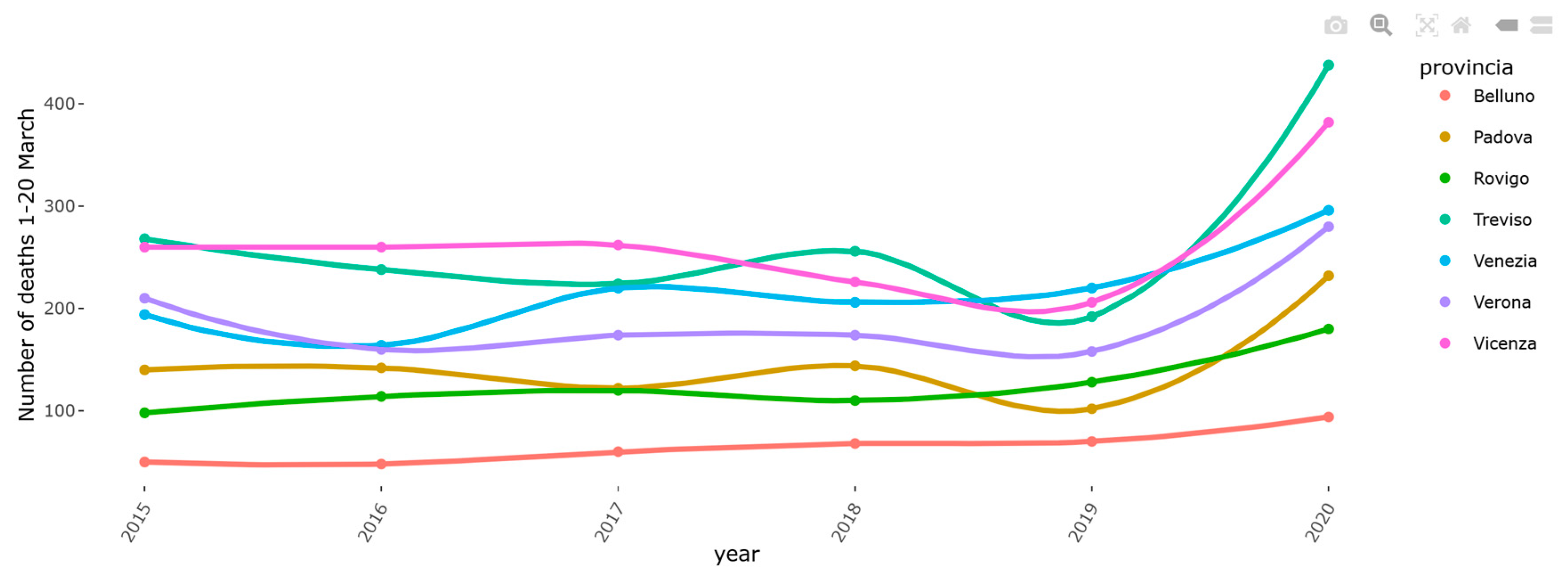
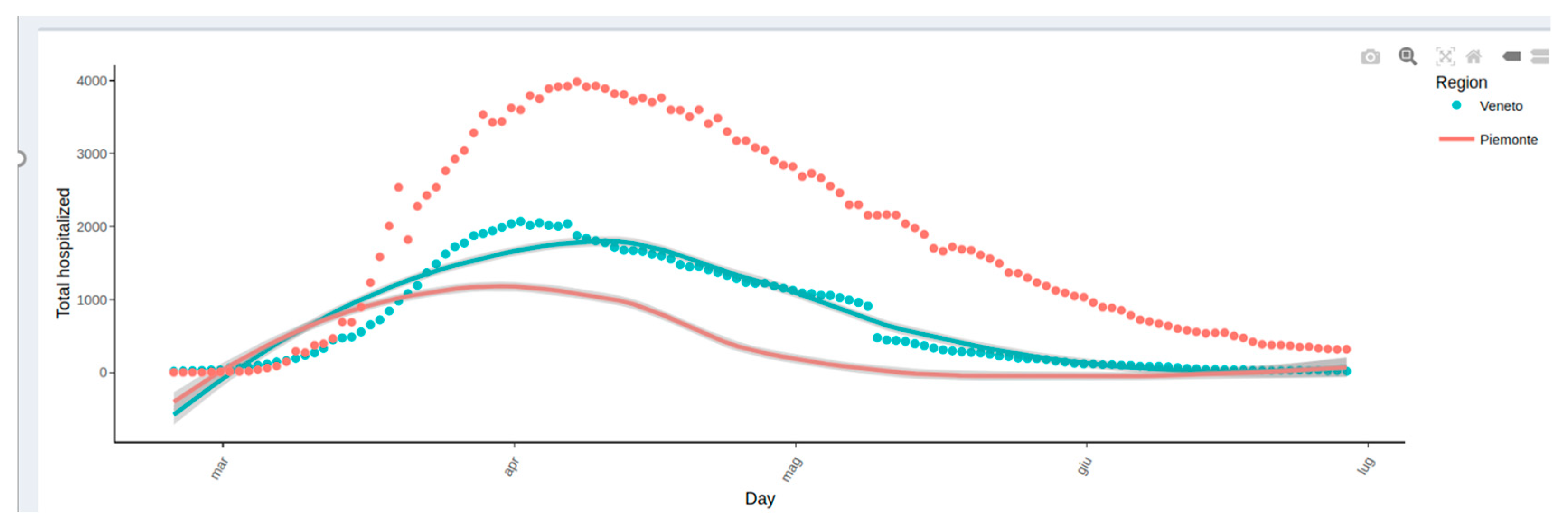
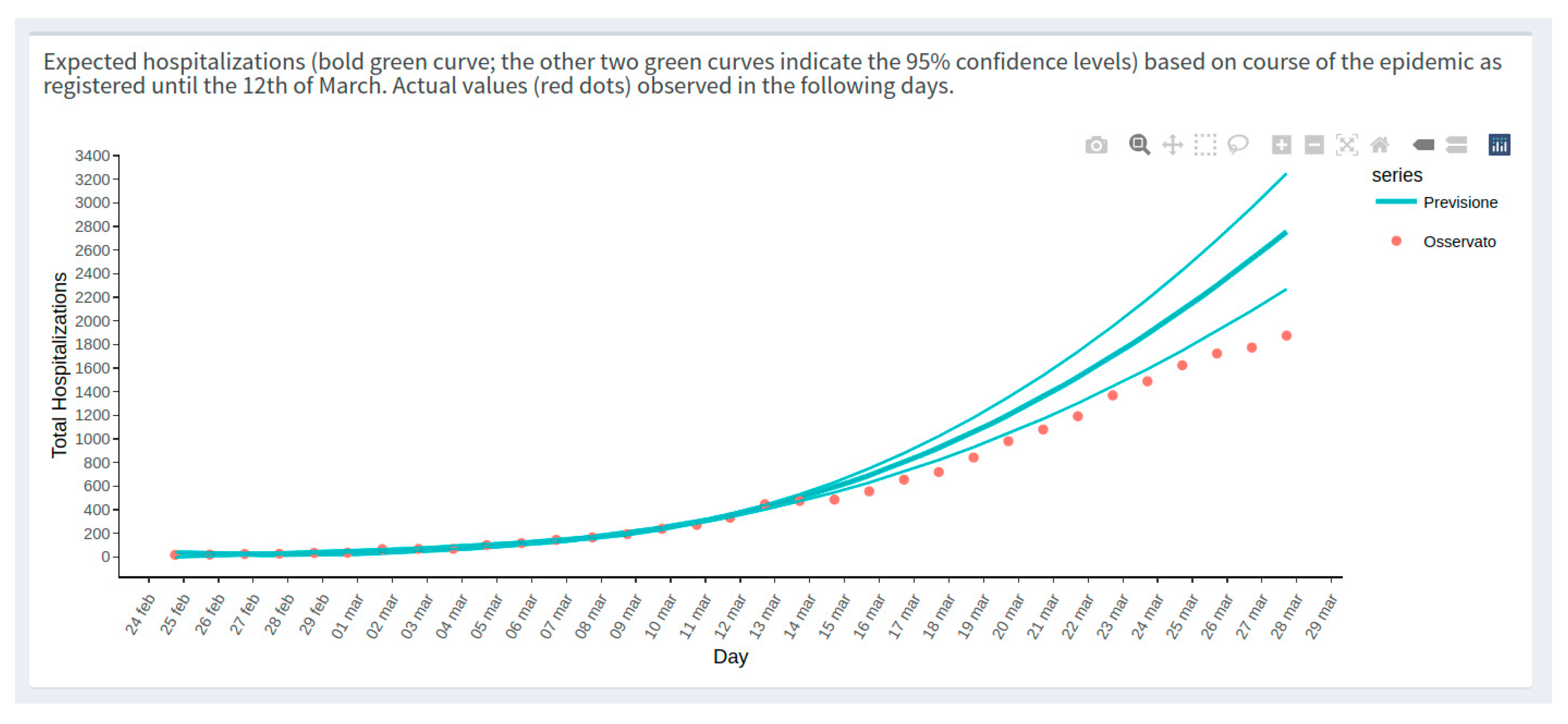
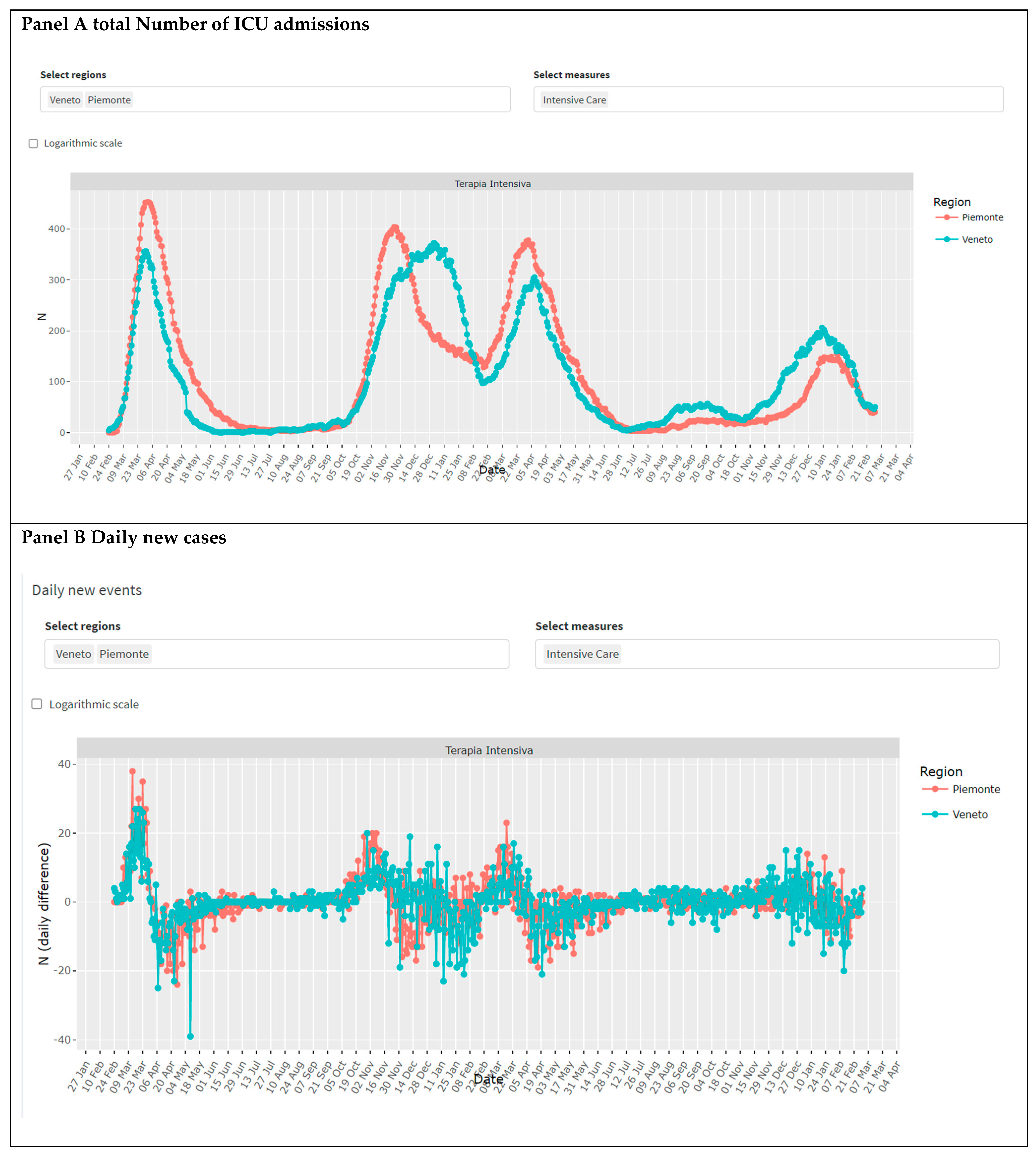
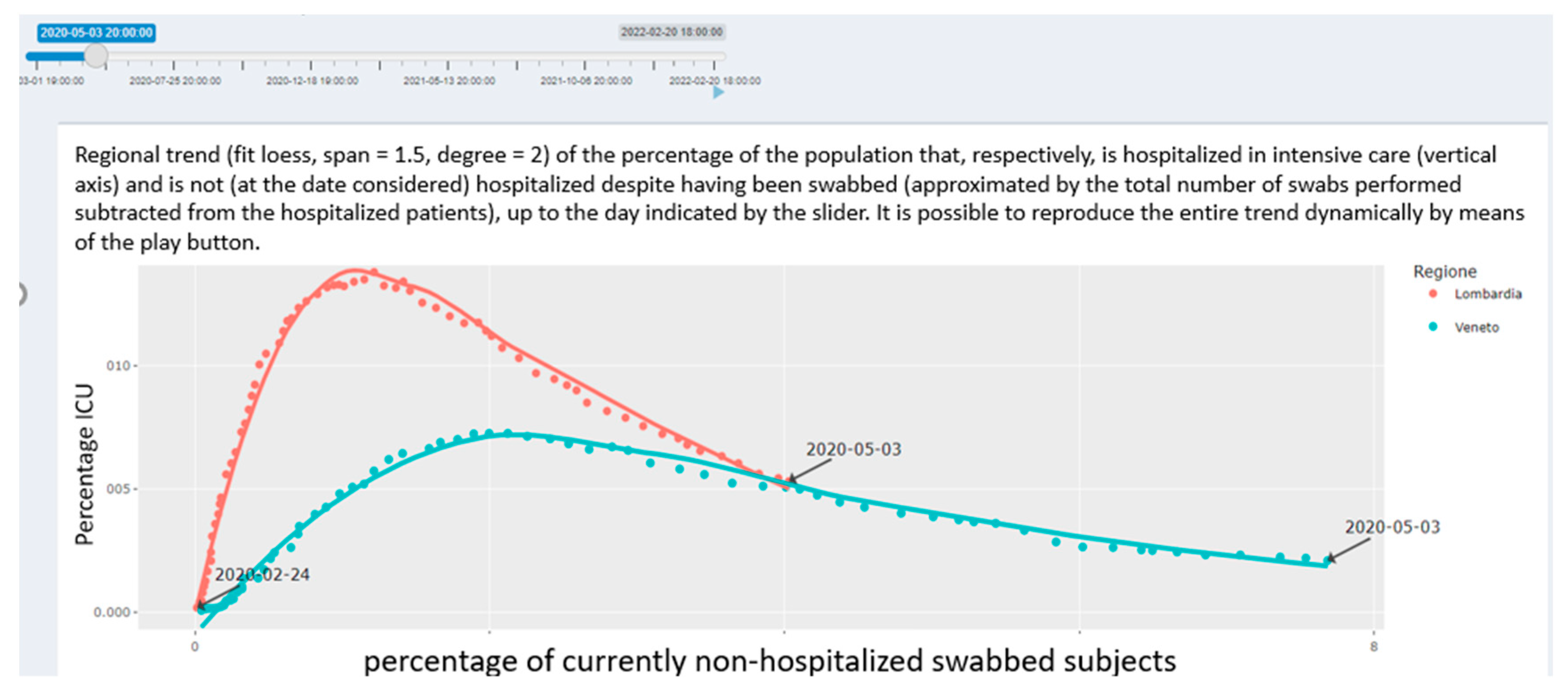
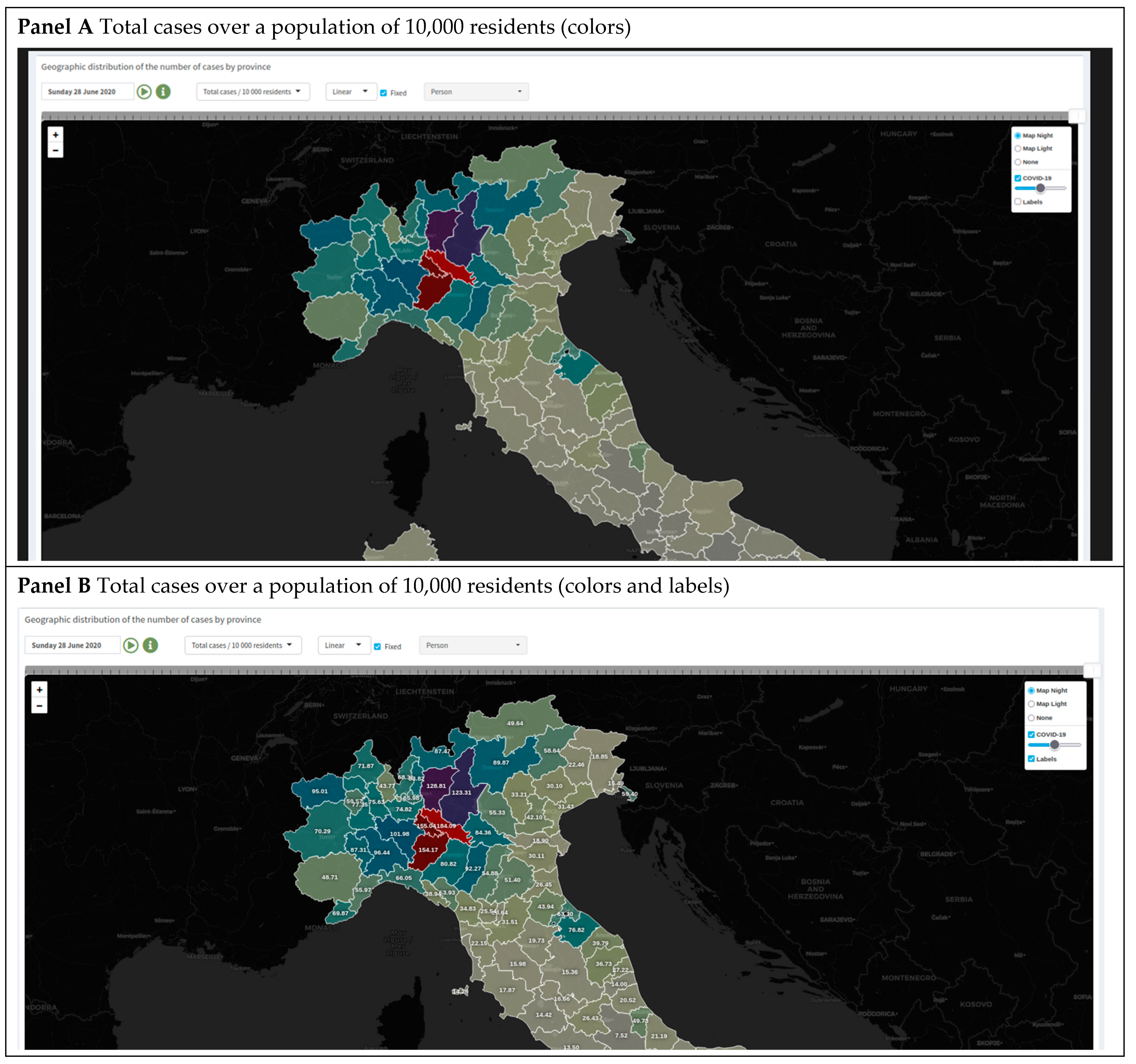
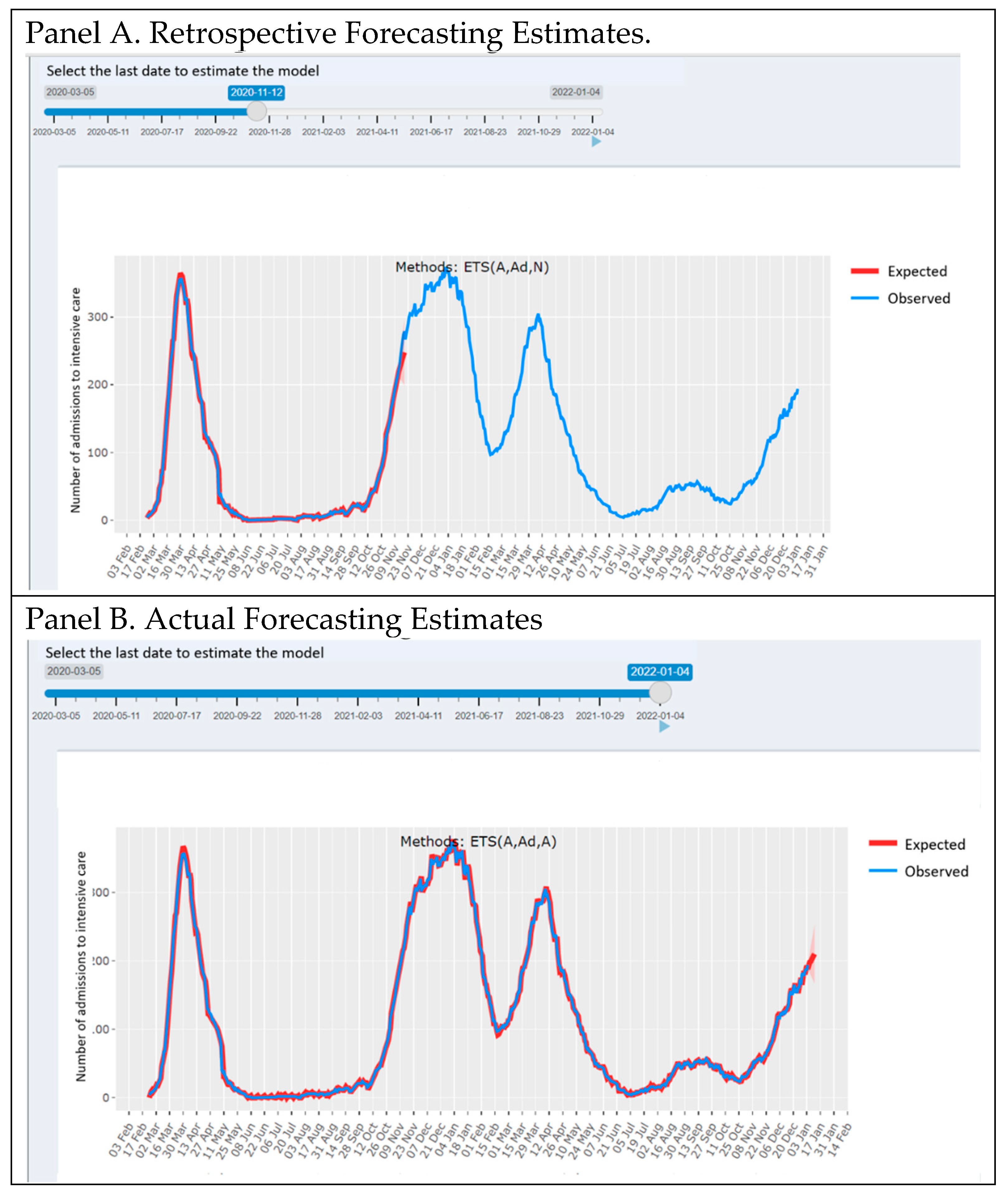
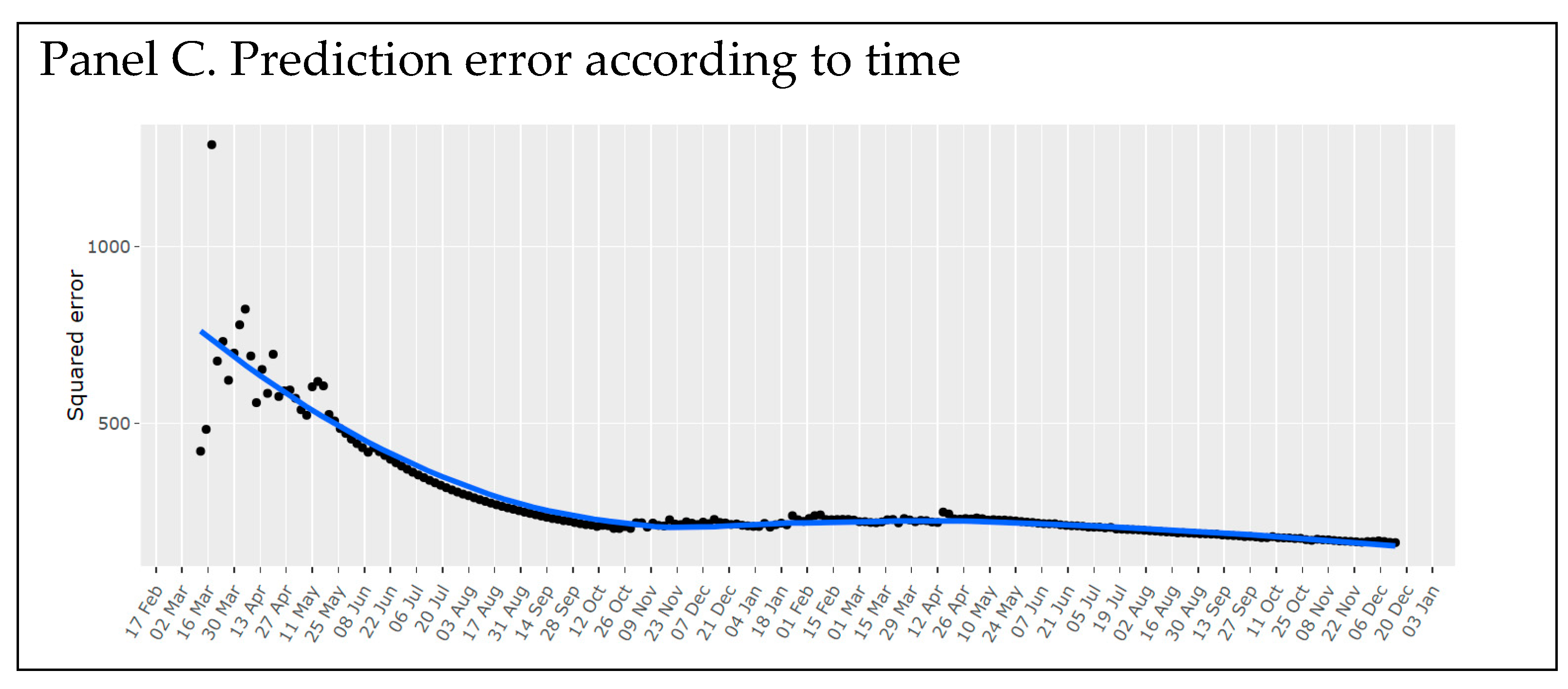
Publisher’s Note: MDPI stays neutral with regard to jurisdictional claims in published maps and institutional affiliations. |
© 2022 by the authors. Licensee MDPI, Basel, Switzerland. This article is an open access article distributed under the terms and conditions of the Creative Commons Attribution (CC BY) license (https://creativecommons.org/licenses/by/4.0/).
Share and Cite
Lanera, C.; Azzolina, D.; Pirotti, F.; Prosepe, I.; Lorenzoni, G.; Berchialla, P.; Gregori, D. A Web-Based Application to Monitor and Inform about the COVID-19 Outbreak in Italy: The {COVID-19ita} Initiative. Healthcare 2022, 10, 473. https://doi.org/10.3390/healthcare10030473
Lanera C, Azzolina D, Pirotti F, Prosepe I, Lorenzoni G, Berchialla P, Gregori D. A Web-Based Application to Monitor and Inform about the COVID-19 Outbreak in Italy: The {COVID-19ita} Initiative. Healthcare. 2022; 10(3):473. https://doi.org/10.3390/healthcare10030473
Chicago/Turabian StyleLanera, Corrado, Danila Azzolina, Francesco Pirotti, Ilaria Prosepe, Giulia Lorenzoni, Paola Berchialla, and Dario Gregori. 2022. "A Web-Based Application to Monitor and Inform about the COVID-19 Outbreak in Italy: The {COVID-19ita} Initiative" Healthcare 10, no. 3: 473. https://doi.org/10.3390/healthcare10030473
APA StyleLanera, C., Azzolina, D., Pirotti, F., Prosepe, I., Lorenzoni, G., Berchialla, P., & Gregori, D. (2022). A Web-Based Application to Monitor and Inform about the COVID-19 Outbreak in Italy: The {COVID-19ita} Initiative. Healthcare, 10(3), 473. https://doi.org/10.3390/healthcare10030473










